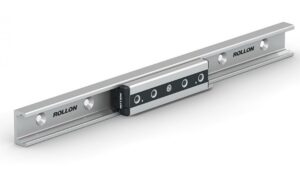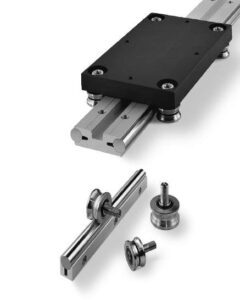Introduction
In the world of precision machinery, linear guide systems are the unsung heroes ensuring accuracy, efficiency, and smooth mechanical motion. Whether used in CNC machining, robotics, or medical devices, these systems transform rotational energy into precise linear movement—enabling industries to achieve unmatched performance.
As automation, robotics, and manufacturing advance, linear guide systems have become more sophisticated—delivering smoother operation, higher load capacity, and longer service life. This evolution has made them indispensable in the race toward precision-driven innovation.
Understanding Linear Guide Systems
A linear guide system is a mechanical arrangement designed to provide stable and precise linear motion with minimal friction. Unlike simple sliding mechanisms, it uses rolling elements—typically balls or rollers—between a rail and a carriage, allowing smooth and accurate movement under various load conditions.
Their purpose is simple but vital: to support and guide motion while minimizing wear and vibration. From semiconductor fabrication to aerospace assembly, linear guide systems are essential wherever precision and repeatability are critical.
Components of Linear Guide Systems
The reliability of linear guide systems depends on their components, each engineered for durability and performance:
Guide Rails: Provide a rigid, accurate track for linear motion.
Carriage (or Slider): Moves along the rail carrying the load.
Rolling Elements: Balls or rollers that minimize friction.
End Caps & Seals: Protect the guide from dust, chips, and debris.
Lubrication Ports: Facilitate smooth, continuous operation.
Each part contributes to the overall rigidity, smoothness, and lifespan of the linear guide.
How Linear Guide Systems Work
At its core, a linear guide system converts rotational motion into frictionless linear movement. The carriage glides along a hardened steel rail using rolling elements that distribute the load evenly across contact points.
This uniform load distribution minimizes wear, improves stability, and ensures that even under heavy loads or high speeds, movement remains smooth and accurate.
Materials Used in Linear Guide Systems
Material selection is crucial for achieving durability and reliability. Common materials include:
Stainless Steel: For corrosion resistance and hygiene-critical environments.
Carbon Steel: For heavy-duty applications requiring strength.
Ceramics: For low-weight, high-precision systems.
Composite Polymers: For lightweight, budget-friendly setups.
Advanced coatings like chrome plating or black oxide improve resistance against wear and corrosion.
Types of Linear Guide Systems
Ball Type Linear Guides: Provide low friction and high-speed motion.
Roller Type Linear Guides: Offer greater load-bearing capacity and rigidity.
Magnetic Linear Guides: Enable contactless motion ideal for cleanrooms.
Each type serves unique operational needs, depending on accuracy, load, and environment.
Comparison Between Linear and Slide Bearings
| Feature | Linear Guide Systems | Slide Bearings |
|---|---|---|
| Friction | Extremely low | Moderate to high |
| Accuracy | High precision | Low precision |
| Load Capacity | High | Medium |
| Maintenance | Minimal | Frequent lubrication |
| Application | CNCs, robotics, automation | General machinery |
Linear guide systems outperform traditional slide bearings in nearly every high-precision scenario.
Key Features of Linear Guide Systems
High load-bearing capacity
Exceptional rigidity and accuracy
Smooth and silent operation
Low friction coefficient
Long operational lifespan
These features collectively ensure the stability and efficiency that modern industries demand.
Advantages of Using Linear Guide Systems
Improved Precision: Essential for CNC and robotic systems.
Enhanced Speed and Smoothness: Supports consistent high-speed movement.
Reduced Wear: Rolling friction extends component life.
Low Maintenance: Requires minimal lubrication and servicing.
High Repeatability: Ensures accuracy in repetitive tasks.
Linear guide systems are a cost-effective solution for improving industrial reliability and productivity.
Industrial Applications
Linear guide systems have a vast range of applications:
CNC Machining Centers: For accurate tool and part positioning.
Robotic Arms: To achieve high-speed and repeatable motion.
Medical Devices: Precision positioning in imaging and testing equipment.
Packaging Machinery: Smooth and controlled product movement.
Semiconductor Production: Particle-free motion in cleanrooms.
Each of these sectors benefits from the system’s superior motion control and reliability.
Design Considerations
When designing linear guide systems, engineers must consider:
Load and Force Distribution: Dynamic vs. static loads.
Speed and Acceleration: Affects lubrication and wear rates.
Alignment Tolerance: Ensures even bearing contact.
Environmental Conditions: Temperature, humidity, dust exposure.
These factors influence both performance and longevity.
Load Capacity and Rigidity
Load capacity defines how much weight a guide can carry without deformation. Linear guide systems are designed to handle both static loads (stationary) and dynamic loads (in motion) with minimal deflection.
Rigidity ensures stability even under extreme conditions, maintaining precise alignment and accuracy.
Lubrication and Maintenance
Proper lubrication is vital for smooth, long-lasting performance.
Use compatible grease or oil based on the manufacturer’s recommendation.
Schedule lubrication intervals based on speed and workload.
Employ self-lubricating options for maintenance-free performance.
Regularly inspect seals and wipers to prevent contamination.
Common Issues and Troubleshooting
Noise and Vibration: Often due to insufficient lubrication or misalignment.
Uneven Motion: Caused by dirt or bearing wear.
Reduced Accuracy: Check preload or mounting flatness.
Corrosion or Rust: Use proper coatings and environmental protection.
Early detection and prompt maintenance prevent major mechanical issues.
Installation Guidelines
Proper installation ensures optimal performance:
Align rails accurately using precision tools.
Mount on flat, rigid surfaces.
Use even torque on bolts to prevent distortion.
Test movement before full operation.
A well-installed system guarantees long-term reliability.
Selecting the Right Linear Guide System
Consider the following before purchasing:
Application type (precision machining, automation, robotics)
Required load and travel distance
Environmental conditions (temperature, moisture, dust)
Lubrication access and maintenance feasibility
Matching the system to your specific needs ensures maximum return on investment.
Cost-Performance Analysis
While linear guide systems may have higher upfront costs, their performance and durability justify the expense. Over time, reduced downtime, lower maintenance costs, and improved product quality deliver outstanding ROI.
Innovations in Linear Motion Technology
Recent innovations include:
Smart Sensors: Real-time load and wear monitoring.
AI Predictive Maintenance: Reduces downtime.
Self-Lubricating Carriages: Eliminates manual servicing.
Noise Reduction Designs: Enhance operator comfort.
Technology continues to push the boundaries of what linear guide systems can achieve.
Sustainability in Manufacturing
Manufacturers are now adopting sustainable methods such as:
Using recyclable metals and eco-friendly lubricants
Reducing waste via precision CNC machining
Implementing low-energy heat treatment processes
These efforts align with global sustainability goals without compromising quality.
Case Study: Linear Guide Systems in CNC Machining
A European aerospace firm replaced its standard guides with precision linear guide systems. The results were impressive:
40% faster machining cycles
25% reduction in vibration-induced errors
50% longer maintenance intervals
The investment led to better accuracy, fewer defects, and enhanced productivity.
Role in Robotics and Automation
In robotic systems, linear guide systems ensure repeatable, controlled motion — vital for tasks like assembly, packaging, and welding. Their rigidity and accuracy make them perfect for high-speed, multi-axis automation.
Global Market Overview
The global market for linear guide systems continues to expand, fueled by robotics and Industry 4.0 adoption. Key manufacturers include THK, Hiwin, NSK, Bosch Rexroth, and IKO. Asia-Pacific leads the market in production, innovation, and demand.
Future of Linear Guide Systems
The future is smart and self-aware. Expect systems equipped with IoT connectivity, embedded diagnostics, and autonomous lubrication mechanisms. These advancements will make predictive maintenance and performance optimization effortless.
Safety Standards and Compliance
To ensure safety and reliability:
Follow ISO 14728-1/2 standards for linear motion.
Verify load and speed limits before use.
Implement protective covers and lubrication systems.
Compliance ensures consistent performance and worker safety.
Expert Tips for Extended Lifespan
Keep rails clean and dry.
Use manufacturer-approved lubricants.
Avoid overloading beyond rated capacity.
Periodically check alignment and preload.
Following these steps can extend the system’s lifespan by years.
FAQs
What is a linear guide system used for?
It’s used to enable precise, low-friction linear motion in machinery such as CNCs, robots, and automation systems.
How often should linear guide systems be lubricated?
Depending on usage, lubrication is typically needed every 500–1000 operating hours.
Are linear guide systems maintenance-free?
Some models feature self-lubricating components, but most require periodic care.
Can they be used in cleanroom environments?
Yes, stainless steel and sealed models are designed for contamination-free settings.
What causes linear guide wear?
Misalignment, lack of lubrication, and overloading are common causes.
Do they support high-speed applications?
Yes, ball-type guides can operate efficiently at high speeds with minimal friction.
Conclusion
The linear guide system is the backbone of precision motion in today’s automated world. Its combination of rigidity, accuracy, and smooth operation makes it essential for industries that demand excellence. As technology advances, these systems will become smarter, more durable, and more sustainable—propelling industrial efficiency to new heights.
Inbound Link Suggestions:
Link to “CNC Machine Calibration and Maintenance Guide”
Link to “Understanding Motion Control Components”
Outbound Link Suggestions:




